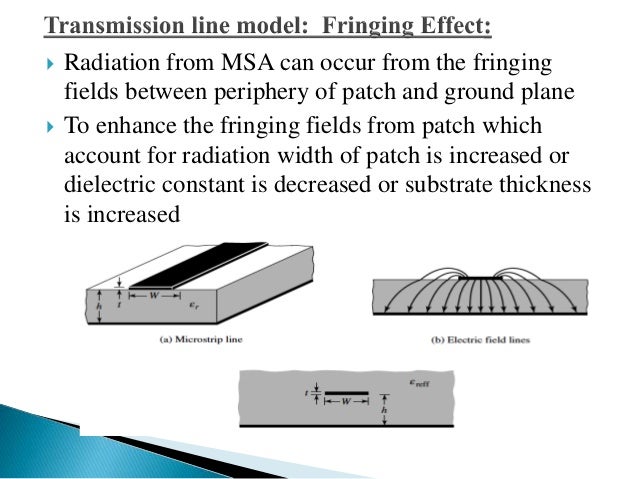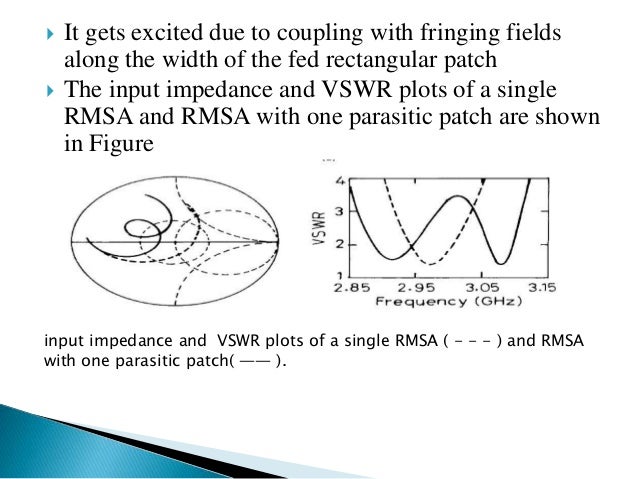Fringing Field In Microstrip Patch Antenna Primer
Fringing Fields for Microstrip Antennas. Note that the fringing fields near the surface of the patch antenna are both in the +y direction. Hence, the fringing E-fields on the edge of the microstrip antenna add up in phase and produce the radiation of the microstrip antenna. This paragraph is critical to understanding the patch antenna. Microstrip Antenna - Transient Fields (the Movie) The microstrip antenna will feed the patch offset from the center, as shown in Figure 1. Offset feed for Patch Antenna. The transient pulse will be of the form given by exp (- (t-T0)/T )^2, where T0 is the time delay and will be 45 pS (picoseconds, 10^-12).
Microstrip Patch Antenna Ppt
In telecommunication, a microstrip antenna (also known as a printed antenna) usually means an antenna fabricated using microstrip techniques on a printed circuit board (PCB).[1] It is a kind of internal antenna. They are mostly used at microwavefrequencies. An individual microstrip antenna consists of a patch of metal foil of various shapes (a patch antenna) on the surface of a PCB (printed circuit board), with a metal foil ground plane on the other side of the board. Most microstrip antennas consist of multiple patches in a two-dimensional array. The antenna is usually connected to the transmitter or receiver through foil microstriptransmission lines. The radio frequency current is applied (or in receiving antennas the received signal is produced) between the antenna and ground plane. Microstrip antennas have become very popular in recent decades due to their thin planar profile which can be incorporated into the surfaces of consumer products, aircraft and missiles; their ease of fabrication using printed circuit techniques; the ease of integrating the antenna on the same board with the rest of the circuit, and the possibility of adding active devices such as microwave integrated circuits to the antenna itself to make active antennas.
Patch antenna[edit]
The most common type of microstrip antenna is the patch antenna. Antennas using patches as constitutive elements in an array are also possible. A patch antenna is a narrowband, wide-beam antenna fabricated by etching the antenna element pattern in metal trace bonded to an insulating dielectric substrate, such as a printed circuit board, with a continuous metal layer bonded to the opposite side of the substrate which forms a ground plane. Common microstrip antenna shapes are square, rectangular, circular and elliptical, but any continuous shape is possible. Some patch antennas do not use a dielectric substrate and instead are made of a metal patch mounted above a ground plane using dielectric spacers; the resulting structure is less rugged but has a wider bandwidth. Because such antennas have a very low profile, are mechanically rugged and can be shaped to conform to the curving skin of a vehicle, they are often mounted on the exterior of aircraft and spacecraft, or are incorporated into mobile radio communications devices.
Advantages[edit]

Microstrip antennas are relatively inexpensive to manufacture and design because of the simple 2-dimensional physical geometry. They are usually employed at UHF and higher frequencies because the size of the antenna is directly tied to the wavelength at the resonant frequency. A single patch antenna provides a maximum directive gain of around 6-9 dBi. It is relatively easy to print an array of patches on a single (large) substrate using lithographic techniques. Patch arrays can provide much higher gains than a single patch at little additional cost; matching and phase adjustment can be performed with printed microstrip feed structures, again in the same operations that form the radiating patches. The ability to create high gain arrays in a low-profile antenna is one reason that patch arrays are common on airplanes and in other military applications.
Such an array of patch antennas is an easy way to make a phased array of antennas with dynamic beamforming ability.[2]
An advantage inherent to patch antennas is the ability to have polarization diversity. Patch antennas can easily be designed to have vertical, horizontal, right hand circular (RHCP) or left hand circular (LHCP) polarizations, using multiple feed points, or a single feedpoint with asymmetric patch structures.[3] This unique property allows patch antennas to be used in many types of communications links that may have varied requirements.
Rectangular patch[edit]
The most commonly employed microstrip antenna is a rectangular patch which looks like a truncated microstrip transmission line. It is approximately of one-half wavelength long. When air is used as the dielectric substrate, the length of the rectangular microstrip antenna is approximately one-half of a free-space wavelength. As the antenna is loaded with a dielectric as its substrate, the length of the antenna decreases as the relative dielectric constant of the substrate increases. The resonant length of the antenna is slightly shorter because of the extended electric 'fringing fields' which increase the electrical length of the antenna slightly. An early model of the microstrip antenna is a section of microstrip transmission line with equivalent loads on either end to represent the radiation loss.
Specifications[edit]
The dielectric loading of a microstrip antenna affects both its radiation pattern and impedance bandwidth. As the dielectric constant of the substrate increases, the antenna bandwidth decreases which increases the Q factor of the antenna and therefore decreases the impedance bandwidth. This relationship did not immediately follow when using the transmission line model of the antenna, but is apparent when using the cavity model which was introduced in the late 1970s by Lo et al.[4] The radiation from a rectangular microstrip antenna may be understood as a pair of equivalent slots. These slots act as an array and have the highest directivity when the antenna has an air dielectric and decreases as the antenna is loaded by material with increasing relative dielectric constant.
The half-wave rectangular microstrip antenna has a virtual shorting plane along its center. This may be replaced with a physical shorting plane to create a quarter-wavelength microstrip antenna. This is sometimes called a half-patch. The antenna only has a single radiation edge (equivalent slot) which lowers the directivity/gain of the antenna. The impedance bandwidth is slightly lower than a half-wavelength full patch as the coupling between radiating edges has been eliminated.
Other types[edit]
Another type of patch antenna is the planar inverted-F antenna (PIFA).The PIFA is common in cellular phones (mobile phones) with built-in antennas.[5][6]The antenna is resonant at a quarter-wavelength (thus reducing the required space needed on the phone), and also typically has good SAR properties.This antenna resembles an inverted F, which explains the PIFA name. The PIFA is popular because it has a low profile and an omnidirectional pattern.[7]These antennas are derived from a quarter-wave half-patch antenna. The shorting plane of the half-patch is reduced in length which decreases the resonance frequency.[8]Often PIFA antennas have multiple branches to resonate at the various cellular bands. On some phones, grounded parasitic elements are used to enhance the radiation bandwidth characteristics.
The folded inverted conformal antenna (FICA)[9] has some advantages with respect to the PIFA, because it allows a better volume reuse.
References[edit]
- ^Lee, Kai Fong,; Luk, Kwai Man (2011). Microstrip Patch Antennas. World Scientific. pp. 8–12. ISBN184816453X.CS1 maint: extra punctuation (link)
- ^'Welcome to antennas 101'by Louis E. Frenzel, 'Electronic Design' 2008
- ^Bancroft, R. Microstrip and Printed Antenna Design Noble Publishing 2004, chapter 2-3
- ^Lo, Y.T., Solomon D. andRichards, W.F. 'Theory and Experiment on Microstrip Antennas,' IEEE Transactions on Antennas and Propagation, AP-27, 1979 pp. 137-149.
- ^'PIFA - The Planar Inverted-F Antenna'.
- ^Iulian Rosu.'PIFA – Planar Inverted F Antenna'.
- ^Taga, T. Tsunekawa, K. and Saski, A., 'Antennas for Detachable Mobile Radio Units,' Review of the ECL, NTT, Japan, Vol. 35, No.1, January 1987, pp. 59-65.
- ^'Inverted-F Antenna (IFA)'at antenna-theory.com
- ^Di Nallo, C.; Faraone, A., 'Multiband internal antenna for mobile phones,' Electronics Letters , vol.41, no.9, pp. 514-515, 28 April 2005
External links[edit]
- Microstrip Antennas antenna-theory.com
- Microstrip Antenna Tutorial EM Talk
Fringing effect is the magnetic characteristic caused by theshape around directly opposing the magnetic surfaces.
What is fringing effect in magnetic field?
How do you reduce magnetic fringing effect?
Why fringing field of micro strip antenna is bended at the edges of this antenna?
What is the most famous Fringing coral reef?
How are barrier and fringing reefs alike?
What is flux fringing and where does it occur?
Define gap contraction factor for slots?

What is fringing effect?
Where is a fringing reef found?
How many types of field effect transistor?
What are fringing reefs and what are they made of?
What is fringing in capacitor?
How field effect operates in organic chemistry?
What are fringing reefs?
Fringing Field In Microstrip Patch Antenna Primer Chart
Does field spell cards affect Armityle the Chaos Phantom's effect?
What is the effect of a magnetic field on a stationary electric field?
What are the three types of reefs?
What do fringing reef eat?
Are fringing reefs threatened or endangered?
What happens to the fringing reef as the island sinks?
3 types of coral reefs?
What are 3 types of coral reefs?
What are the 3 types of reefs?
How do you use kurivolts effect. Can I use the effect without having it on the field?
Differences between anomalous zeeman effect and normal?
What is the use of substrate in Field Effect Transistor?
What is the difference between a fringing reef and a barrier reef?
What are fet?
Does a magnetic fIEld have an effect on a capacitor placed in between the plates?
Does the size of a magnet effect the magnetic field?
Can you activate Ojamagic's effect by activating it on the field?
What causes Jupiter's magnetic field?
What are 4 type of corals?
What does a fringing coral reef look like?
Does Shakira know Arabic?
What types of animals live in a fringing reef?
Why is MOSFET is called IGFET?
What is Shielding n deshielding effect in nmr?
What effect does increased magnification have on the field of vision?
What are three different types of reef?
Where is electric field uniform?
What will be the effect on the motion of electron if it travels along the dirction of electric field?
Does stardust dragon negate caius the shadow monrchs effect?
Is the effect of Retilianne Medusa permanent?
What is the effect of the current in the electromagnet?
What is another word for earths magnetic field?
What happens to the fringing as the island sinks?
What is the largest coral fringing reef in the world?
What are the three types ofr reefs?
